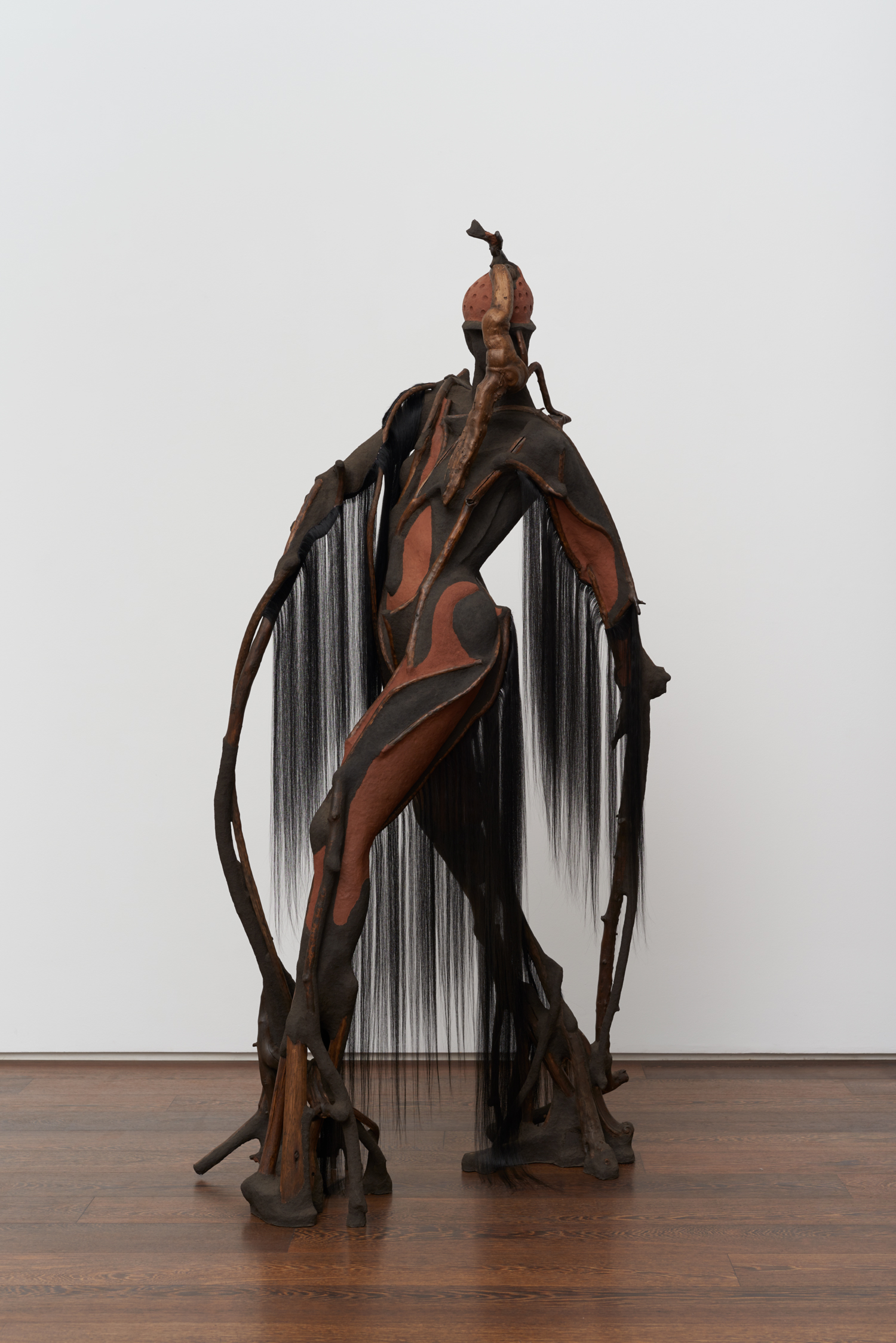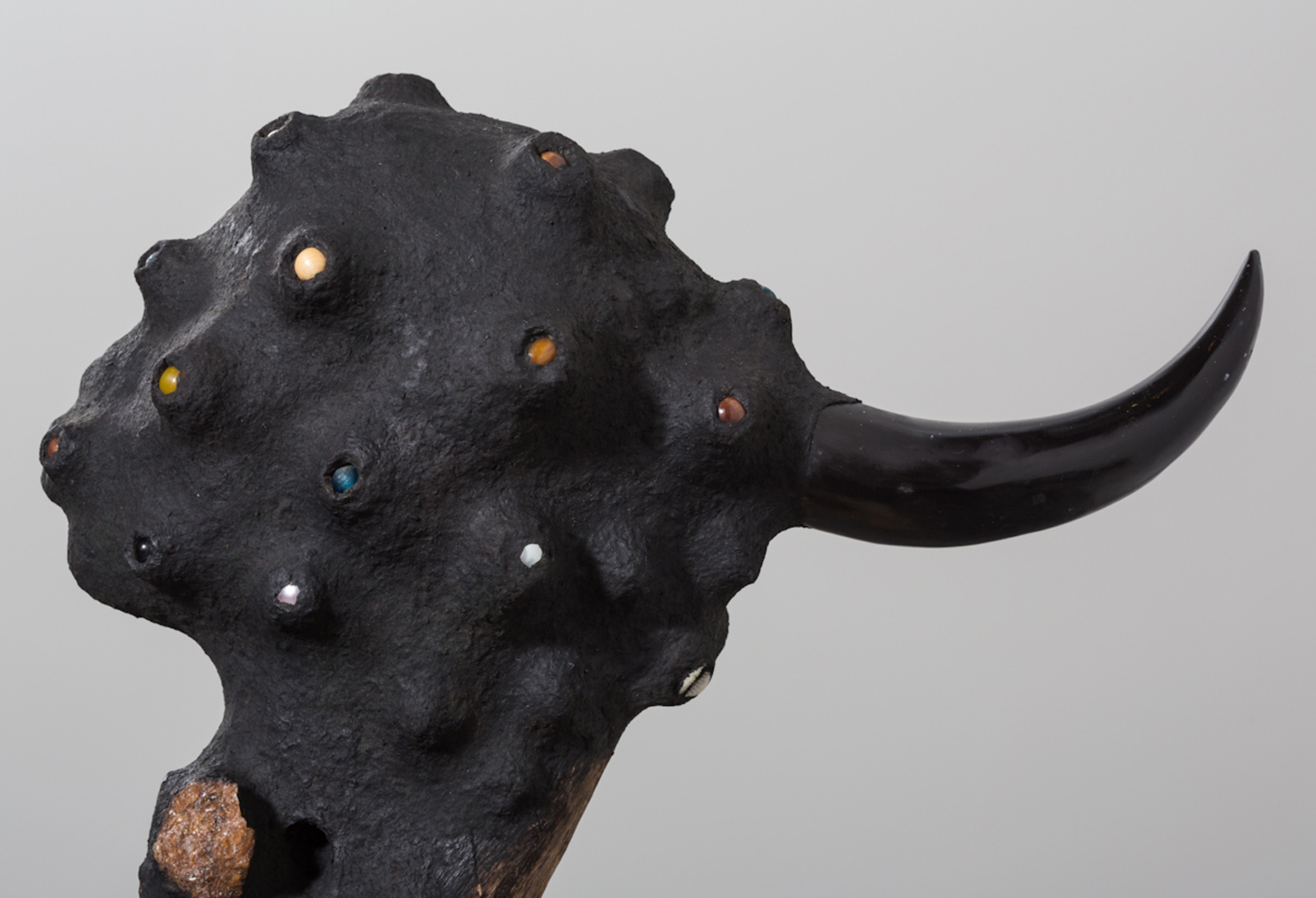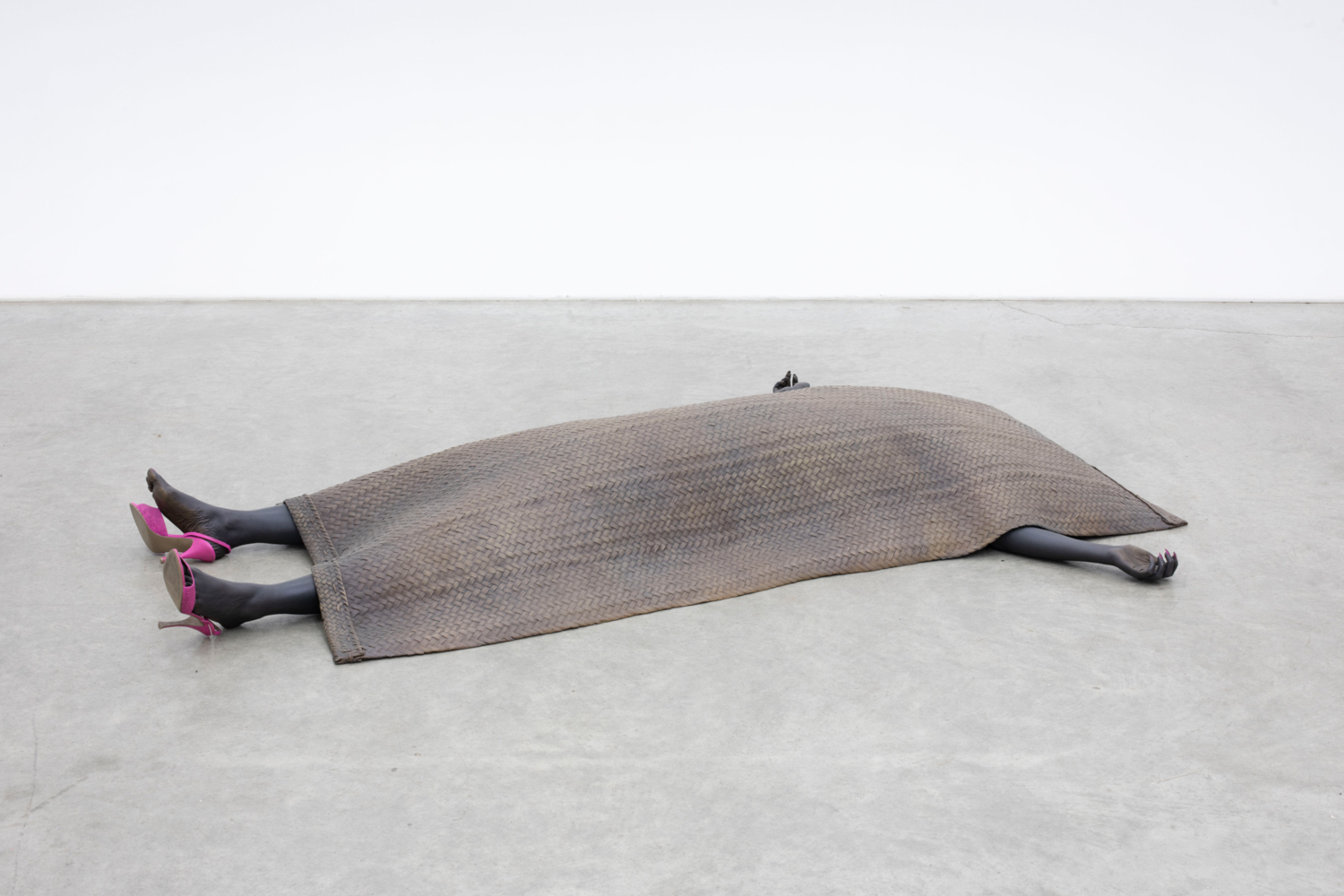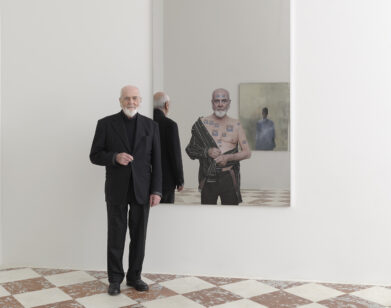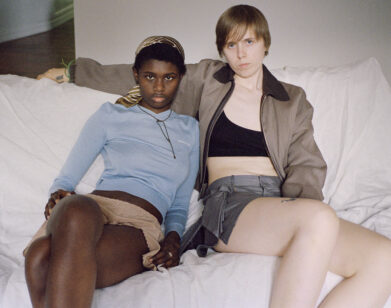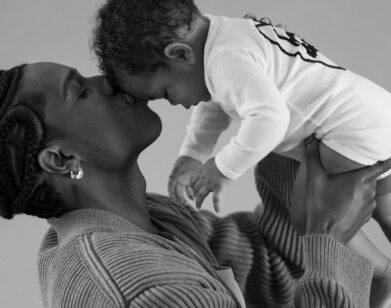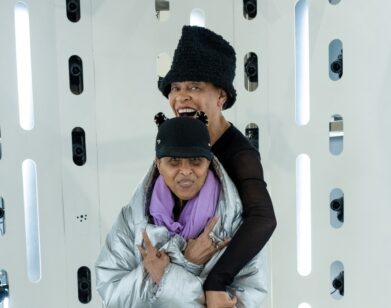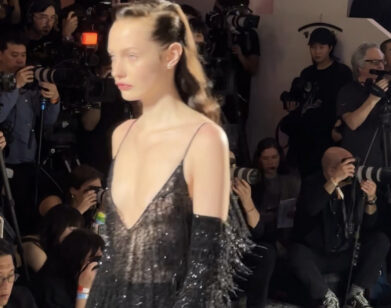art
Wangechi Mutu and Carrie Mae Weems on the Profound Impulse to Make Art
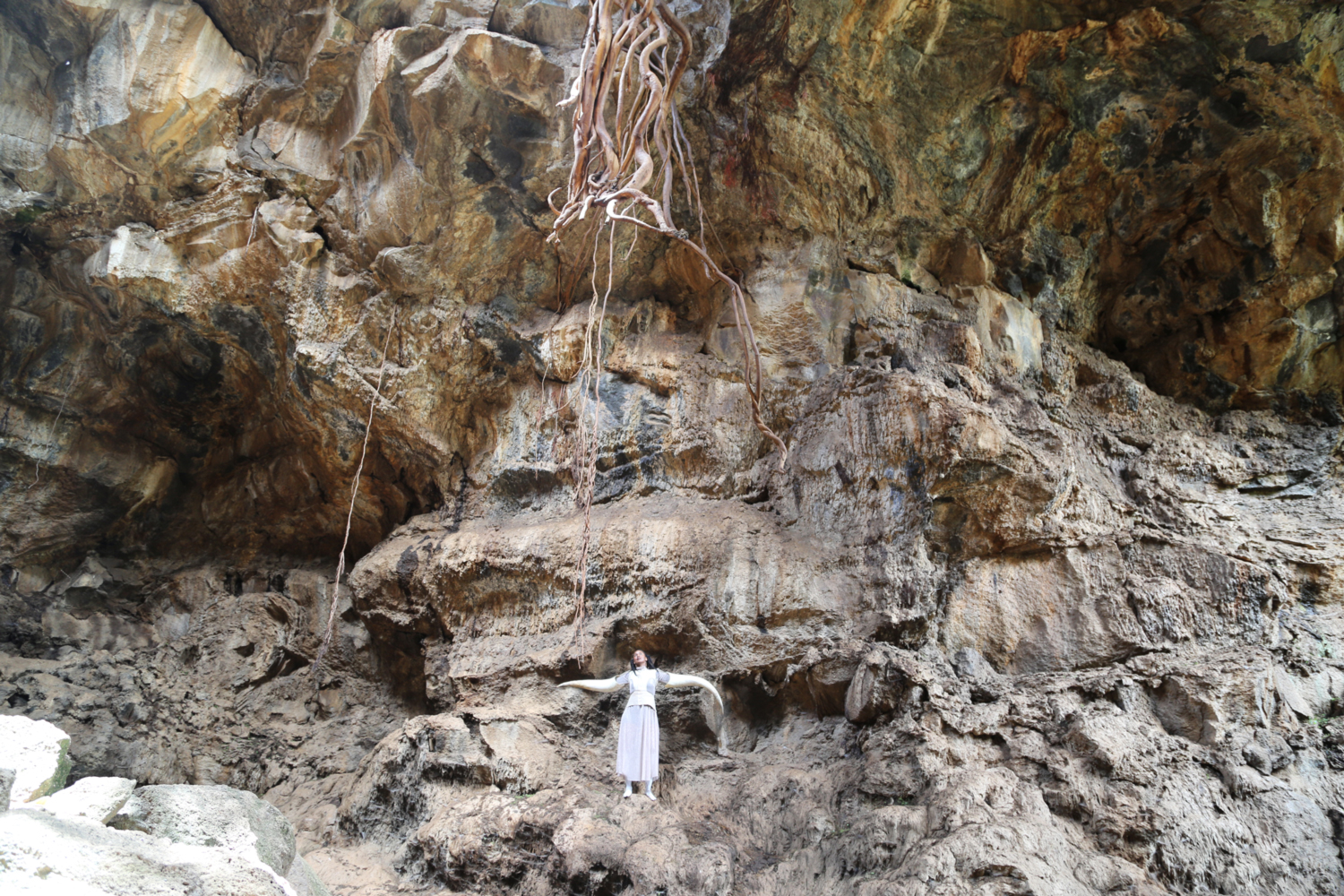
Courtesy the Artist and Gladstone Gallery, New York Brussels. Photo credit Cynthia Edorh.
Wangechi Mutu builds worlds. In fact, the 48-year-old multimedia artist doesn’t stop with terrestrial concerns such as material and form—she creates whole new mythologies for her vivid, ever-expanding artistic domain, in- venting radical cosmological creatures that can be seductive, monstrous, secretive, triumphant, and all-powerful, as if mating folklore with sci-fi cyborgian fantasy. Mutu has often been linked with Afrofuturism—the cultural movement that welds the iconography and history of the Black diaspora with advanced technology to evoke alternate futures and embolden an awakening consciousness. Mutu’s paintings, sculptures, performances, and films explore questions of authority, environmentalism, love and violence, spiritualism, and the sacred and the profane. Yet, time and again, it is the Black female body that Mutu seems to return to as a central thesis, testing and re-arming it, reinscribing its terms, and peeling away all of its out-dated and overburdened connotations.
Mutu was born and raised in Kenya. She moved to Wales for school and went on to establish her art career in the United States, eventually setting up a studio in Bed-Stuy, Brooklyn. It was there, in the early 2000s, that she first made a stir for creating a series of collage paintings that reworked magazine imagery—the corner store was her artistic armory and everything from fashion to porn was up for grabs— into tantalizing, anthropomorphic, surrealist forms. Mutu is an experimenter, continually expanding her repertoire. Such gems have included an animated short film about post-apocalyptic consumption with the singer Santigold (The End of eating Everything, 2013) and her sublime and mysterious bronze-cast caryatids stationed outside the doors of the Metropolitan Museum of Art for the past year. Much of Mutu’s materials and symbology stems from her native Kenya, and in 2016, the artist built a second studio in Nairobi. It is from there, reflecting on history, dragging raw materials from the landscape into her workspace to incorporate into her new sculptures, even making her own clay, that Mutu has created her latest bodies of work, which are slated to be shown this spring at a major solo exhibition at San Francisco’s Legion of Honor museum, as well as at New York’s Gladstone Gallery. Earlier this fall, Mutu spoke with her friend, the venerable American artist Carrie Mae Weems, about creation myths and real-world strategies. — CHRISTOPHER BOLLEN
———
CARRIE MAE WEEMS: We’ve known one another in so many ways for many years. Just the other day, I ran across a photo of us together with [the late artist] Terry Adkins’s wife, Merele [Williams-Adkins], at an exhibition downtown [the designer Duro Olowu’s More Material at Salon 94, 2014 ]. There was such a wonderful group of artists and collectors who came together at that show.
WANGECHI MUTU: Isn’t that what great occasions have the power to do? We are so busy, and I do enjoy my time alone, but I tend to connect with
people—and remember how much I miss them—at openings and shows. And that’s where I get to see you quite often. One occasion that sticks in my mind is when we all gathered for Terry’s memorial. I remember thinking, “This is the breadth and scope of people that this man brought together through the power of his art.” Now, we’re going to have to renegotiate the space that art and artists’ lives create in their absence. We’re going to have to figure out how to gather again, you know?
WEEMS: We will. Now, of course, I miss having my friends in my home, sitting at my table and eating my food. I miss holding people. But this moment will pass, too. In the meantime, we’re able to have this conversation via video. I’m curious, what was Wangechi like as a young woman? I want to know when you realized you were an artist.
MUTU: Oh, boy. It goes back to when my family came to terms with the fact that this art thing that I had decided I wanted to pursue wasn’t just a whim or a hobby or some kind of demon possession. [Laughs] Well, it might still be a bit of a demon possession, but it’s a good demon and I invite it and bring it in. But the truth is, I know for a fact that I was born this way and didn’t have to try to make myself an artist. If anything, I fought against it because I knew the resistance and the repercussions and the stigma that came with being an artist, particularly for a kid in a middle-class African home in the ’70s and ’80s. It just wasn’t realistic. It wasn’t practical. It was lunacy. We got our independence in Kenya in ’63, ’64, so I was born into a country that was new and hopeful. The last thing they wanted was to see us fail.
WEEMS: I can imagine.
MUTU: But I was a compulsive drawer from an early age. I drew not because I was anxious or because I was trying to say something. I drew the way I rode my bike. It was as natural as anything. Making an accurate drawing eventually came pretty easily to me, but I also knew it was a technical thing, a kind of robotic behavior. So I thought, “Well, this is just the thing that I can do. It’s a way of maneuvering through the world that I have a knack for.”
I went through my 12 years of Catholic school, an amazing school that in some way clobbered us into shape and prepared us for the world, but also clobbered a lot of the individuality out of the young girls. I knew there was no way I was going to come out of there as some kind of expressive, artistic person. At the time, President Moi was in power, and he was extremely repressive, and stifled journalists and writers. But in my late teens, I got an opportunity to go to school abroad. I hate to make it seem like it was because I left that I found my voice, but it was because I stood separate and was in no way held up. No one knew who I was, so I had to say who I was, and it was through the art that I was able to articulate a semblance of who this little teenage girl was, what I wanted, and how I wanted to be heard and seen. It was in my high school years that I began to understand the potential for art to hold a space for yourself in society that’s respectable. We went to studios. We discussed art history. We looked at varieties of art-making that made me realize it wasn’t just about rendering an accurate drawing. It was about the potential for a human to speak to others through their own unique experience. And that blew my mind.
WEEMS: Where did you go to school?
MUTU: I went to this high school in Wales when I was 17, and then I did the international baccalaureate, which is quite a well-rounded education system. But more than anything, what mattered was that I was far away from home. I was homesick. I was around other kids who were also homesick. We had to figure out who we were and what we wanted to do: “How is this world that we’ve inherited going to sort itself out through our various skills?”
WEEMS: I also knew that I was going to be an artist very early in life. I didn’t know what kind of artist I was going to be. Like you, I could draw well. I was already attuned and quite sensitive to the world around me. I was interested in theater and dance by the time I was 10. I would come home from school with my books and I would head straight up to my bedroom and close the door. I would sit there writing in my diary about who I was and who I wanted to be and where I wanted to go.
MUTU: That’s awesome.
WEEMS: Right? Of course, there were stumbles and starts. But there is this sort of magical idea that you are an artist and that you have the ability to craft and shape and construct the life that you want to live. Do you think that given all you now know, that you are being seen and heard in the way you imagined you would be?
MUTU: That’s a difficult question. The art I make is almost like my children, these things that come from inside me. Does the world accept and invite these ideas the way I want it to? Not necessarily. Of course, there’s always a space between what your motivations are with a work and how that work is interpreted by people. Perhaps what makes an artist successful is how small that space can get between what I intended and what you’re seeing. One thing I’m amazed and challenged by is how the immigrant voice is contextualized within the United States. When I first began thinking of my work from a professional perspective, I remember thinking how much explaining there was to do, not in terms of what the work was about, but in terms of who I was and where I came from, in a way that more privileged or entitled artists, or a white male artist, doesn’t necessarily have to do. When I began working in the world, it was honestly still a little exotic to be a Black artist and definitely an African woman artist.
WEEMS: I think that’s absolutely true. The explaining, it seems to me, has to do a great deal more with trying to contextualize Blackness. It’s not really about the work. It’s about trying to figure out how to contextualize you. There’s always a sense that this idea about race has to be unpacked in relationship to Blackness, right? And so the work then becomes the sidebar. It’s never really front and center, being critiqued or analyzed for what it’s actually doing or not doing. The person, not the work, is what’s being critiqued.
MUTU: It’s almost like, “Wow, who invited you to this party? How did you get here?” That said, I’ve found in your work a real sensibility that didn’t just recognize African women, but recognized African women’s work, adornment, appearance, and history vis-a-vis how they present themselves. I remember one particular photographic series with Mangbetu women’s heads [from “Here I Saw What Happened and I Cried,” 1995–1996]. That work impacted me tremendously. This was in the late ’90s when I was coming out of graduate school. I remember at that time thinking how much I wanted to claim my presence without necessarily confirming the terror and racism and colonialism thrust upon us. There was a people before colonization. There was a history before the missionaries. In fact, there were thousands of years of original languages and culture that eventually migrated to all of these other continents before any of these brutalities and atrocities were placed upon us. There still is a language separate from all of these atrocities within us. I wanted to see what that was about, and try to express that.
WEEMS: Are the questions being asked by a work different in the United States than they are in Kenya? How does that perception vary?
MUTU: There are many different audiences. And there are many different reactions. Some people are louder, and some people’s podiums are given more emphasis. I think the work that I make is sometimes most appreciated by young people. I see my work in other people’s work. I hear my work in the voices of students when they talk about it. I feel the impact of my work in symposiums and conferences and papers. As far as mainstream reactions go, I’m not so sure. I do feel like the most profound reactions to my work have come from young thinkers and makers, as well as older thinkers and makers who are not necessarily interested in being public about their reactions. I end up having a lot of great conversations. But if we’re talking about countries, well, I’m a dual citizen now. And, of course, the country that holds the most power and wealth and gravitas, the United States, is now being challenged. What is the responsibility if you have all that money and power and pull and collateral and aggression? I was born in this little country that’s smack on the equator that was colonized by the British. We’ve had quite a bit of stability. Kenya had the highest population growth in the world in the 1980s. We were making more babies than anybody else, this little country. And that has a lot to do with health, with enough food, and with vaccination. The other side of that reality is that women were not getting educated as to how many kids they could support. Therefore, a lot of women were having more babies than they could feed because they were going off of the traditional model, which is to have many babies because they’ll help you work, then they will get married and bring in more wealth. It was a very traditional transition into what is essentially a modern country now.
WEEMS: The art, too, in that country has changed.
MUTU: When I was growing up, there was this incredible hybrid of folkloric artists who were coming out of traditional oral literature, traditional mythological fable-telling, traditional carving and object-making, and traditional painting. There was a lot of that feeling of your grandmother’s stories. And even with all of the urbanization of Kenya in the 1970s and ’80s, everyone’s grandparents were still from the countryside, and the art recognized that experience. Then, along the way, there was a profound trauma that came from Kenya having gone through this dictatorship where art and literature and poetry and free speech were utterly repressed. People weren’t just told, “Shut up.” They were punished, tortured, kicked out, killed—all kinds of things happened during the ’80s and into the ’90s. The country was essentially screaming to be a place of multiple voices. Some of the art that happened around that time was able to speak of those experiences, but it wasn’t the kind of art found in a white-cube gallery. It was people who were able to move between Kiswahili and Kamba and Kikuyu, the languages that people understood. It was people who were able to make jokes that were pinpointing language nuances and the personalities of the politicians and the idiosyncratic behavior of the wealthy, all that kind of stuff. It was in the form of theater. It was in the form of accessible art. It was not arts and crafts.
Today, there’s a generation of young people who have never experienced a dictatorship, who don’t understand what the repression was like. If my mom walked by when I was on the phone as a kid and I mentioned anything political, I’d get in trouble. If I was in a restaurant and I started talking politics, I’d get a kick under the table. It’d be like, “Do you know where we are?” That didn’t happen to the 20-year-olds who are now in the arts sphere. But I left before all of that had ended. In fact, I left around when multiparty politics was realized. We instituted multi-party power and five-year presidential terms as opposed to an infinite presidential term. That was the country growing up. I remember leaving Kenya and thinking, “I’m so glad to be out of that. That silence was so loud and heavy.” But I do have a deep memory of these beautiful works that in some ways harken back to another time, a time before European invasion, a time before English. Now, the artwork is definitely more about the individual. People’s focus has gone toward the sense that art is about you saying what you feel about your experience. I think contemporary art has a very individualistic and, at the same time, a very empathetic role. It separates you from the community to some degree, but at the same time, it expects you to bind yourself to what that community is going through, to utter for them what they cannot say.
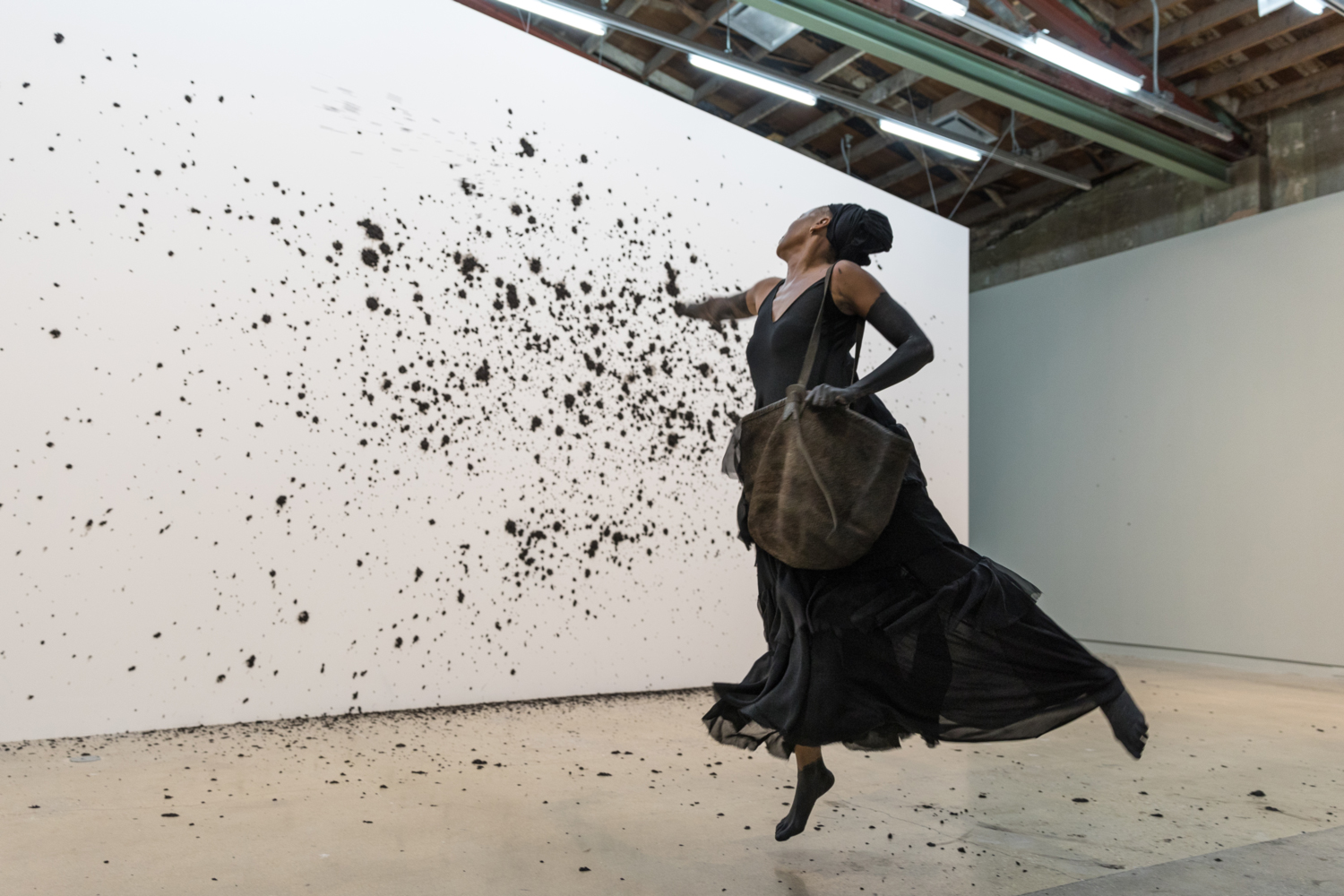
“Throw,” 2017. Performance view, September 19, 2017. © Wangechi Mutu. Courtesy the artist and Gladstone Gallery, New York and Brussels. Image courtesy The Contemporary Austin. Photograph © Giulio Sciorio.
WEEMS: I want to ask you about your process. You have a number of upcoming exhibitions all over the world. What is your practice of putting together a body of work?
MUTU: I’m very emotional about where I am. My location has always influenced my work. Even if it’s just a residency in a different part of the city, I’ve always found that the move from what I was comfortable with into a new space recalibrates my mind, and even that little bit of discomfort provides me with a ton of space and ideas and a whole new set of worries and solutions. You know, New York is my adopted home, but Kenya is my mother/fatherland. It brings out a whole set of inclinations and interests. I used to say, “I love New York, but it’s so ugly.” Of course, there are many things about New York that are extremely beautiful, but when you get to a land that actually has a voice, that actually speaks… I mean the land itself, not just the human beings who live on it. There’s an actual voice that you can hear in a place. Nature still has a great role to play in Nairobi. It’s a very cosmopolitan city, but there’s a real resonance of land and nature that is much more soulful than I’ve ever felt in New York. The first thing I did when I got here was start collecting things from the garden and from our drives and from the beach, and dragging them back into the studio. They’ve become the bones and organs and ornaments for these incredible objects I’m making. And they’re each a part of a long poem broken up into stanzas about my life here and my love of being here. I try to put these objects together in the form of characters, in the form of these spirits that can speak of a place and a time that is probably in the future, when we are able to live in harmony with one another, in harmony with the land, and in harmony with what literally has created us. I think it has something to do with Kenya being one of the areas where humans first became human. I think there’s something about our brain that recognizes the landscape here. I think there’s something about the silences that you don’t really find in the city. You probably know what I mean because you live upstate.
WEEMS: I completely understand. I remember going to Mississippi for the first time, going to the Seal Islands for the first time, going to the Delta for the first time, going to New Orleans. Who we are in the United States grows out of our relationship to that soil. And buried in the layers of that soil is a meaning and relationship to that soil. And then going to South Africa, to Johannesburg and Cape Town, flying over this ancient territory where levels of excavation could go on for the next million years and you still wouldn’t come to the bottom of it, there is this idea that the land can tell us these fundamental stories about who we are.
MUTU: Exactly.
WEEMS: This brings us back to how we started the conversation. One of the great gifts we have is that we are who we are. We are Brown people with the extraordinary history that comes with that. I think our sense of self is always rooted in the communities out of which we come. One way or another, we speak to that, even if we would prefer not to. And the gift we bring to the art world is that while we can be profoundly contemporary, deeply modern—and we are probably some of the deepest modernists that have come out of the 19th and 20th centuries—the work has this duality and a sense of purpose. It’s an extraordinary gift. No one has written about the multiplicity of the work that African Americans, Africans, and Latino Americans have used to advance and inform modernism. It’s an important discussion: that you are who you are, that you are responding to the world around you in a very deep and critical way, that you’re engaging the moment and your place in history and struggling to figure out how to bring that into the practice. It is extraordinary.
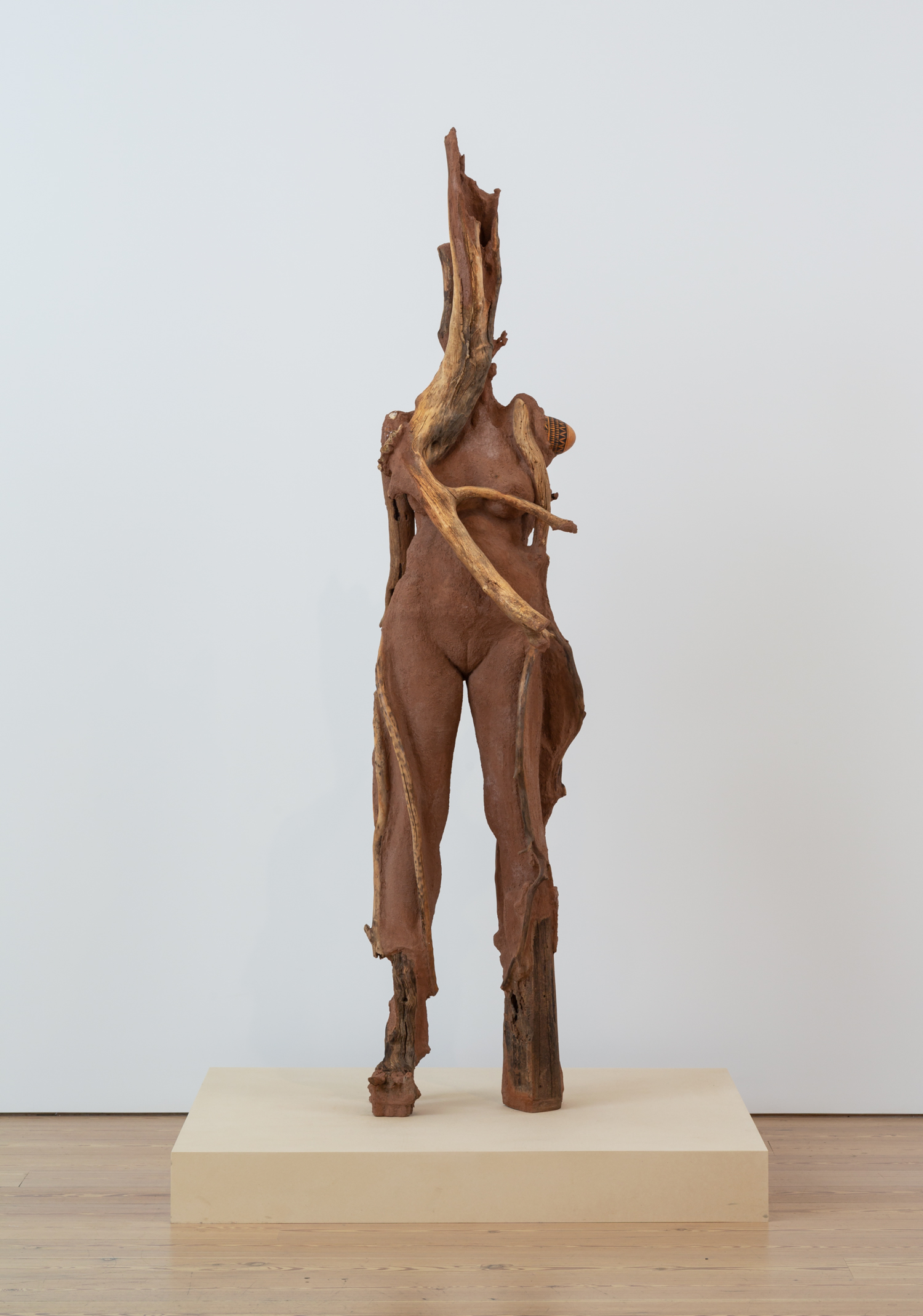
“Sentinel I,” 2018. Photographed by Ron Amstutz, Courtesy the Whitney Museum of American Art, New York.
MUTU: I never imagined that making art would be of any use to anyone, including myself, if it wasn’t speaking about something that grounded me, if it wasn’t about the story that was coming out of my relationship to my family, to my land, to the people I love, to the people I don’t love anymore, or to the people I want to love. Art-making was never just about being expressive. For me, it is very much about the utterance of humanity. It’s like thinking about ancient cave paintings—to see in those images of land and sky and animals committed to rock that we’ve been grappling with our existence as humans for all this time. And art has given us a way of saying, “It’s going to be okay. You are going to get through the night.” That impulse is art-making at its most profound. I do believe that the most grounded, clear, and compassionate artists are always trying to find a way to communicate that same thing, to say, “Yes, this is a scary world, but we will get through the night like we have for tens of thousands of years.”
WEEMS: I’m thinking about James Baldwin, who, by the way, had such a deep crush on my partner. He would call my house and say, “Oh, hi, yes, it’s Jimmy.” [Laughs] In his essay on the responsibility of artists, he brings up this idea that every day you get up and you face the depths of your emotion and tease them out. Being an artist is borne out of what you must do, not necessarily out of what you want to do. And there are days when I would much rather be doing anything but working in my studio. And yet I find myself in my studio every day, dealing with the subjects and the ideas and the concerns that matter to me most. To a great extent, I think I’ve sacrificed a lot. I spend a great deal of time alone, in my studio, and I need to. I need an awful lot of room for all that’s bubbling up inside of me. You have to endure so much in order for the work to come to the surface and then be laid out in whatever form or fashion that it will. But that birthing is what we do. And to bring something to life is no small feat if you’re serious about it. What do you yourself want from your work?
MUTU: I often speak in the language of a mother, because I think it’s a great metaphor. I want to prepare and nurture these ideas, and touch and mold and speak to and listen to them, to the point where I know they’re ready. I try to do this exercise of seeing the work 10, 20, 30 years from now in places and spaces, in environments where I have had massive epiphanies or deep museum-room crushes, where I’m just floored. Or even in books and places that I’ve been so inspired by. I want these objects not to make sense, and not to represent me per se, but to feel ready for their time.
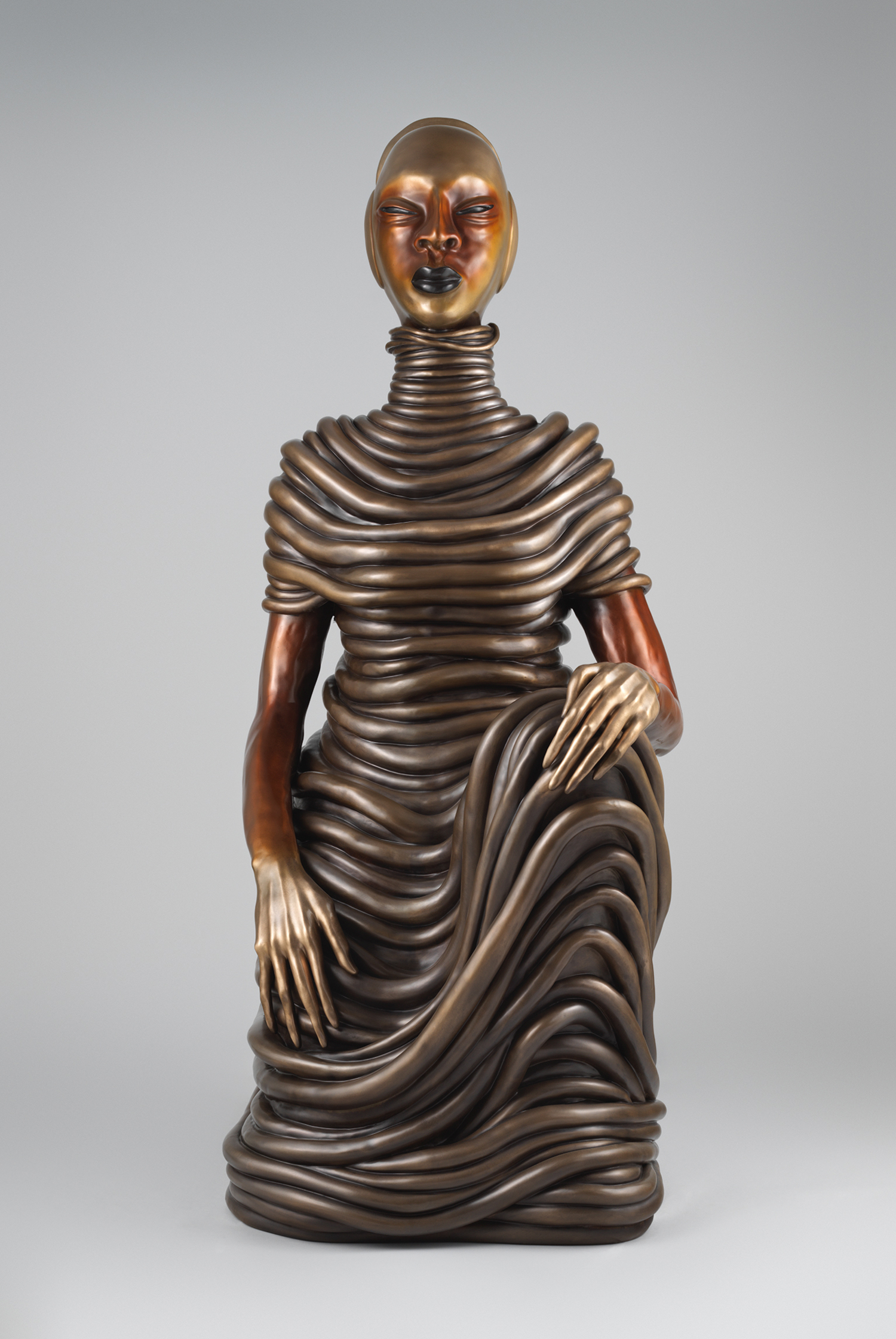
“The Seated III,” 2019. Courtesy of the Artist and Gladstone Gallery, New York and Brussels. The Metropolitan Museum of Art, Photograph by Joseph Coscia, Jr.
———

